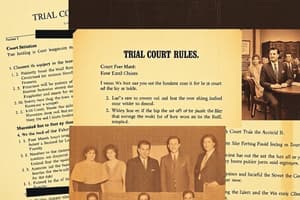Podcast
Questions and Answers
What is the purpose of a docket in a court of justice?
What is the purpose of a docket in a court of justice?
An official summary of the proceedings in a court of justice, containing a list of cases awaiting trial and the names of the parties to pending litigation.
What is the function of a brief in a legal case?
What is the function of a brief in a legal case?
To outline the pertinent facts of the case, present the questions of law to be decided, present the position of the lawyer’s client as to those questions, and list the legal arguments and authorities supporting the client’s position.
How are court documents classified?
How are court documents classified?
Court documents are materials filed in relation to a legal case before the courts.
What distinguishes court-related documents from other legal documents?
What distinguishes court-related documents from other legal documents?
What is the general classification of any document that contains information on legal issues?
What is the general classification of any document that contains information on legal issues?
What is the difference between docket and brief in the context of legal documents?
What is the difference between docket and brief in the context of legal documents?
What is an Amicus Brief?
What is an Amicus Brief?
What is the purpose of a Reply Brief?
What is the purpose of a Reply Brief?
What is the main difference between a Summons and a Subpoena?
What is the main difference between a Summons and a Subpoena?
What is the purpose of Interrogatories in a legal context?
What is the purpose of Interrogatories in a legal context?
What is an Affidavit?
What is an Affidavit?
What is the purpose of an Appeal in a legal case?
What is the purpose of an Appeal in a legal case?
What is the function of an Answer in a legal context?
What is the function of an Answer in a legal context?
What is the purpose of a Complaint in a civil action?
What is the purpose of a Complaint in a civil action?
What are some examples of non-court documents?
What are some examples of non-court documents?
What is the purpose of Agreements in legal contexts?
What is the purpose of Agreements in legal contexts?
Flashcards are hidden until you start studying
Study Notes
Court Documents
- A docket is a list of cases to be tried in a court of justice, used to schedule and organize trials.
Briefs
- A brief is a document submitted to a court outlining the arguments and legal grounds of a party's case.
- It is used to present the party's position, summarize the facts, and cite relevant laws and precedents.
Classification of Court Documents
- Court documents are classified into different categories, including pleadings, motions, discovery, and appeals.
- Pleadings include complaints, answers, and replies, which initiate and respond to lawsuits.
- Motions are requests to the court for a specific ruling or action.
- Discovery documents are used to gather information and evidence from the opposing party.
- Appeals are requests to review a lower court's decision.
Court-Related Documents vs. Other Legal Documents
- Court-related documents are filed with the court and are used as evidence in a legal case.
- They are typically formal and follow specific rules and procedures.
- Non-court documents, such as contracts and agreements, are not filed with the court and are used to establish private agreements.
Amicus Briefs and Reply Briefs
- An Amicus Brief is a document submitted to a court by a person or organization that is not a party to the case, but has a vested interest in the outcome.
- A Reply Brief is a response to the opposing party's brief, typically used to counter their arguments.
Interrogatories
- Interrogatories are written questions served on one party by the other, used to gather information and evidence.
Affidavits
- An Affidavit is a sworn statement used to verify the authenticity of evidence or testimony.
Appeals and Answers
- The purpose of an Appeal is to review a lower court's decision, alleging errors or injustices.
- An Answer is a response to a complaint, outlining the defendant's position and defenses.
Complaints
- A Complaint is a document filed with the court to initiate a civil action, outlining the plaintiff's claims and allegations.
Non-Court Documents
- Examples of non-court documents include contracts, agreements, and notices.
Agreements
- The purpose of Agreements is to establish a private understanding or contract between parties, outlining their rights and obligations.
Studying That Suits You
Use AI to generate personalized quizzes and flashcards to suit your learning preferences.




